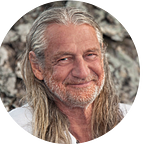The Asana Files: Savasana and Resting
Before beginning your asana practice it is good to rest for a short while, putting aside the demands of regular activity and turning your attention over to the intimacies of body and breath. You may like to chant, listen to music, or place some relaxed attention on significant objects. This will establish the mood or bhavana of the practice.
Yoga begins from savasana, corpse pose, or any passive posture, and moves as the natural movement of life energy or prana of the whole body, usually with easy, simple movements at first.
The body moves easily in the energy of the system throughout the practice. Nothing is imposed. Force disrupts rather than enhances movement of prana.
It may be counterintuitive to consider savasana as the starting point for practice. The point here is that Yoga is the renewal of the body’s natural state of aliveness and feeling-connection.
“Yogis now prescribe savasana, the corpse posture, after the performance of any moving postures. This is backwards. You start yoga as a dead stiff body then the body is renewed through natural rhythmic movements” U.G Krishnamurti writes…
“The movements and postures that the body performs when breaking down the stiffness left over from the death process are beautiful, graceful movements, like those of a newborn baby.”
This is the renewing process of asana.
During our practice it is good to rest between asana in order stay in control of the breath, and to reflect on the transitions. Resting has several uses:
- Resting allows us to relax the breath and give it a chance to ease up. This is important if we are practicing strong asana and our breath is working hard.
- By softening our breath, we slow the heart rate down. One definition of a good Yoga practice, according to my teacher Desikachar, is that the heart rate is slower at the conclusion of the practice than at the beginning.
- A short pause allows for conscious transitions between asana.
- In the moment of transition, we can take a moment to evaluate our practice and how we feel. Maybe we set out with the intention of doing a demanding session but at the mid-point you realize that are actually very fatigued. Here, we can change our course and adapt to our current state.
- Resting between asana also allows for the effects of the previous asana to take place in our bodies and minds; this too, could reveal to us that changes are required: we may need to decrease or increase certain elements.
- Rests should be taken when they are required; when the body becomes fatigued, shakes, or excessively sweats; or when the breath is disturbed.
We also end our practice with savasana. Sadhana happens first: “You must earn your savasana” — T. Krishnamacharya. We do not simply lie down and expect that savasana will arise.
Asana links the mind to its source — the whole body; the bloom of the Heart — allowing the clarity of Life to enter and nourish the mind. The mind relaxes and surrenders its controlling samskaras.
The merge of body and breath allows the inherent intelligence of Life that is the whole body to function and heal without interference from the mind. The body throws out what is not needed and receives what is.
In savasana we are simultaneously alert and profoundly resting; the whole-body settled into Life; abiding in the natural state. The body is the cosmos.
The stillness, power and beauty of the oceans, of the Earth, of the hills and the trees and the horizon is present in your body. The brightness of the stars and the darkness of the space between them is your tangible condition.
If your practice is short stay in savasana for at least one minute. If your practice is longer, your savasana needs to be longer. Give yourself time to absorb the effects of your practice; to pause and integrate the tapas (cleansing fire) of practice.
After an appropriate time in savasana, transition to a comfortable position for pranayama; and then, give over some space for meditation to arise.
Meditation cannot be forced but arises as a siddhi of your practice of merging body and breath. Meditation may last from thirty seconds, to thirty minutes, to an hour; it is spontaneous and cannot be willfully forced. Leave the body alone.
At the conclusion of your full vinyasa — a word that means one’s entire practice not just asana — allow for a short pause before transitioning back to regular activity and the demands of the day.
Remember, asana, pranayama, meditation and Life are a seamless process. The gifts of your practice will naturally permeate your day and all your relationships.
*Join me and my friends in the heart of Yoga online studio to receive a full Yoga education: a practice that is perfect for you as a unique individual.
